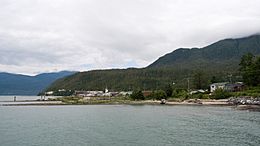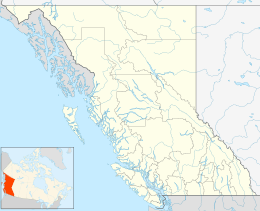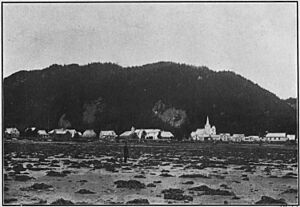Ging̱olx facts for kids
Quick facts for kids
Ging̱olx
Kincolith
|
|
|---|---|

Approaching Ging̱olx from the east
|
|
| Country | |
| Province | |
| Indigenous territories | Nisg̱a'a |
| Established | 1867 |
| Population | |
| • Total | 341 |
| Time zone | UTC−8 (PST) |
| • Summer (DST) | UTC−7 (PDT) |
| Postal code span |
V0V 1B0
|
| Area code(s) | 250 |
Ging̱olx (pronounced gin-golx) is a village belonging to the Nisg̱a’a Nation. It is located in the Nass River valley in British Columbia, Canada. About 400 people live in Ging̱olx.
Ging̱olx is one of four main Nisg̱a’a villages that form the Nisg̱a’a Nation. The community has four important family groups, called clans: Killer Whale, Eagle, Raven, and Wolf. The village government is led by one chief and five councillors.
The name Ging̱olx comes from the Nisg̱a’a language. It means "scalp givers." This name comes from a time when the people of Ging̱olx bravely defended their land. They would fight back against anyone who tried to invade. After winning battles, they would display symbols of their victory along the river. This served as a warning to others.
Contents
Village History
Ging̱olx became a permanent village in 1867. Christian missionaries traveled down the river by raft to start a mission there. The main person who started this mission was Reverend Robert Tomlinson. He was an Anglican medical missionary.
The first European-style buildings in Ging̱olx were built in 1879. These included houses, a school, and a church. Before the missionaries arrived, two main clans lived in the area. The Daaxan of the Killer Whale clan lived on the east side. The Gitxun, the Eagle clan, lived on the west side.
In the 1890s, Reverend William Henry Collison joined the mission. He lived there until he passed away in 1922. His writings tell us a lot about the community during that time.
Overcoming Isolation
For a long time, Ging̱olx was a very isolated village. It is located on the Nass River, close to the Alaska Panhandle. The only ways to reach it were by boat or plane. Because of its remote location and the surrounding mountains, Ging̱olx often had power outages in winter. Sometimes, residents would be without power for up to three weeks. Helicopters were needed to fix the power lines.
Things changed in 2003 when a new road was finished. This 28-kilometer road connects Ging̱olx to Greenville. This meant Ging̱olx was finally linked to the other three Nisg̱a’a communities. The road is called the Kincolith Extension Highway. It connects Ging̱olx to the Nisga'a Highway, which then links to other major highways like the Yellowhead and Cassiar Highways.
Village Economy
Ging̱olx's location is perfect for certain types of work. The main ways people earn money in Ging̱olx are through fishing, forestry (working with trees), and tourism. These activities use the natural resources around the village.
Education for Kids
Children in Ging̱olx go to Nathan Barton Elementary School. This school is part of School District 92 Nisga'a. For high school, students travel to Gitlakdamix, another Nisg̱a’a village.
Culture and Fun
Ging̱olx is a lively place with a rich culture. The village has its own concert band. There are also the Ging̱olx Ceremonial Dancers. They perform at special events like weddings and funerals. They also perform at community celebrations. These celebrations include Crabfest, Seafest, River Boat Days, and the Nisg̱a’a New Year, called Hobiyee.
Hobiyee is an important yearly celebration. Long ago, when the moon looked like a bowl, the first person to see it would shout, "Hoobixim Yee!" This was a way to celebrate. It meant that wildlife would soon be plentiful again.
Hiking and climbing mountains are popular activities. There is a mountain nearby with a "look-out" point. It offers amazing views from three different spots along the trail.
In 1947, the Sons of Kincolith basketball team won the very first All Native Basketball Tournament. This was a big achievement for the community.
Crabfest Music Festival
Crabfest is a popular outdoor music festival held every summer. It started in 2004. The festival has grown a lot and brings in many visitors. People come to see famous bands and talented musicians perform.
The festival lasts for two days. Many well-known artists have played at Crabfest. These include bands like Trooper, Chilliwack, and Nazareth. Famous singers like Buffy Sainte-Marie and Tom Cochrane have also performed. The festival also features local bands and tribute bands from all over Canada and the United States.
Crabfest has a main stage with professional sound and lighting. Many vendors set up stalls along the streets. They sell food, crafts, and other items. This festival has been a big success for Ging̱olx. It brings in tourists from around the world. This helps the local economy a lot, and the positive effects last even after the festival ends.
Ging̱olx Village Leaders
The Ging̱olx Village government is made up of a chief and councillors. They work together to lead the community.
- Chief councillor - George Moore
- Deputy chief councillor - Claude Barton
- Councillor - John Moore
- Councillor - Arlene V. Lincoln
- Councillor - Henry Stephens
- Councillor - Gwen L. Nelson
Important People from Ging̱olx
Many talented people have come from Ging̱olx.
- Norman Tait - A very skilled carver, now deceased.
- Alver Tait - Another master carver.
- Eddie Benson - A talented carver.
- Murphy Oliver Stanley - A master carver, now deceased.
- Nathan Barton - A former Chief of Ging̱olx. He worked hard to get a new administration building built. The local elementary school is named after him.



